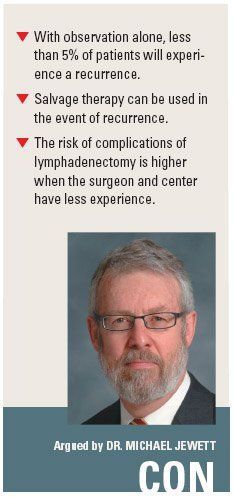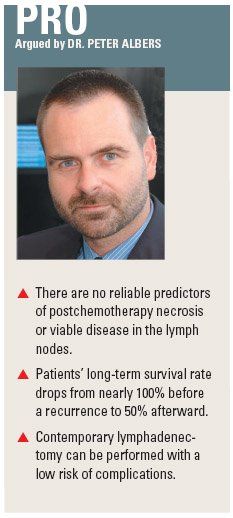Postchemotherapy retroperitoneal lymphadenectomy for NSGCT testicular cancer: For all patients or just some?
MILAN-Some men with nonseminoma germ cell tumor (NSGCT) testicular cancer have a normalization of tumor markers and minimal or no residual masses in the retroperitoneum after chemotherapy. What then? Should all of them undergo retroperitoneal lymph node dissection (RPLND) to be on the safe side, or should the procedure be reserved for selected cases? Leading researchers in urology debated this topic at the 23rd Annual Congress of the European Association of Urology (plenary session 1).
ABSTRACT: Most patients in remission will not experience a recurrence if they skip lymphadenectomy, but identifying those who will remains challenging.
MILAN-Some men with nonseminoma germ cell tumor (NSGCT) testicular cancer have a normalization of tumor markers and minimal or no residual masses in the retroperitoneum after chemotherapy. What then? Should all of them undergo retroperitoneal lymph node dissection (RPLND) to be on the safe side, or should the procedure be reserved for selected cases? Leading researchers in urology debated this topic at the 23rd Annual Congress of the European Association of Urology (plenary
‘We should be more aggressive’
“I take the part that in my opinion, we should be more aggressive in the nonseminomas in taking out the lymph nodes,” stated Peter Albers, MD, chairman of the Department of Urology, Dsseldorf University, Germany (as of August 2008).
Although the 2008 Testis Cancer Guideline from the European Association of Urology endorses surgical resection in patients with normal markers who have any radiologically visible disease (www.uroweb.org), viable disease is not always visible on imaging, he noted.
Dr. Albers described two patients who had normal markers and radiologic complete remissions after chemotherapy. The first patient selected observation and had a recurrence necessitating salvage therapy, followed by another recurrence requiring high-dose chemotherapy, and became unable to work as a result. “Actually this was a disaster-a disaster in my opinion because we did not decide for early surgery and taking out the lymph nodes after the first cycle of chemotherapy,” Dr. Albers commented.

The second patient selected RPLND, which surprisingly revealed a lymph node chain 15 cm long and up to 2 cm wide. “The radiological appearance of the tumor in the CT scan does not correlate with the residual disease you find during surgery,” he observed.
These cases are substantiated by series showing that after chemotherapy, the likelihood of viable disease in residual masses is about 45%, 35%, and 25% in patients whose masses measure less than 20 mm, less than 10 mm, and less than 5 mm, respectively, according to Dr. Albers.
He added that findings at his own institution in recent years have been similar. “So it is not a case of bad imaging, it is just the biology of the disease,” he said.
Although the likelihood of viable disease decreases with the size of the residual mass, “the important message is, there will be no zero values-you cannot predict those patients who will have necrosis after chemotherapy,” he emphasized.
Efforts to do so have met with only limited success, he said. For example, a combination of prechemotherapy alpha-fetoprotein level and chemotherapy- induced shrinkage of masses had a predictive value of 80% at best (Albers P et al: J Urol 171:1835-1838, 2004).
In further support of routine postchemotherapy RPLND, Dr. Albers pointed out, the complication rate has decreased with increasing knowledge of and experience with the surgery, from about 21% in 1982-1992 to 11% in 1990-2002 (Baniel J et al: J Urol 153:976-980, 1995; Mosharafa AA et al: J Urol 171:1839-1841, 2004). Moreover, he said, the complications that do occur are manageable.
“To further reduce the complication rate, we suggest from Germany to reduce the field of surgery to a template resection,” he said, citing a study showing that compared with a full bilateral dissection, a template approach yielded a significantly higher rate of preservation of antegrade ejaculation (85% vs 25%) (Heidenreich AP et al: 2008 ASCO GU meeting, abstract 282).
Summing up his stance, Dr. Albers asserted that currently available indicators are not very helpful when it comes to managing minimal residual masses in patients with NSGCT testicular cancer who have undergone chemotherapy.
“So when in doubt-and this is only true for nonseminoma-I would vote for taking this tissue out, and I would vote to further minimize morbidity by using nerve-sparing techniques in a template fashion.”
As for management after the lymphadenectomy, he recommended adjuvant chemotherapy for patients who have adverse histopathologic findings-positive margins or viable cancer in more than 10% of the specimen-in combination with poor prognostic factors.
‘Not indicated in all patients’
“My position here is that retroperitoneal lymphadenectomy is not indicated in all patients,” stated Michael A.S. Jewett, MD, uro-oncologist at Princess Margaret Hospital and the University of Toronto.

He noted that for the roughly 50% of patients found to have carcinoma or teratoma in residual masses after chemotherapy, resection is believed to be therapeutic because it enables treatment planning and averts future cancer. In contrast, for the 40% of patients found to have necrosis, the procedure is not therapeutic (although it does permit staging and selection of follow-up protocols).
Observation after chemotherapy in selected cases is an evidence-based strategy, Dr. Jewett contended, citing recent guidelines issued by the European Germ Cell Cancer Consensus Group, which state that surgery is not required in patients who have a complete remission (normalized markers and no visible residual lesions) after chemotherapy (Krege S et al: Eur Urol 53:478-496, 2008).
In addition, he noted that the absence of accurate predictors of residual pathology can be viewed as favoring observation as well. “There are many things that have been invoked as predicting residual pathology, and certainly they do increase the chances of finding either necrosis or active tumor or teratoma,” he said. “But none of them are accurate on an individual level. Although they come close, we are not likely to use them to make a decision.”
Dr. Jewett pointed out that with use of a postchemotherapy observational strategy, less than 5% of patients will experience a relapse with longer follow-up (Debono DJ et al: J Clin Oncol 15:1455-1464, 1997).
“We are seeing late relapses for sure, but it appears to be very infrequent, which would suggest that observation is a valid approach,” he commented. Furthermore, salvage therapy can be used if residual disease is found to progress during observation (Hendry WF et al: Cancer 94;1668-1676, 2002).
Postchemotherapy RPLND carries a risk of complications that varies with experience, Dr. Jewett said. “There is no question that this is a bigger issue if the operator is not experienced and, perhaps equally important, the center where the surgery is being conducted is not experienced,” he said.
Offering yet another point in favor of an observational strategy, he observed that when a modified template RPLND is used, the rate of relapse outside of the surgical field is low. “Now this is slightly indirect evidence for support of observation, but it does suggest that observation of some unresected microscopic disease does not result in subsequent progression in most patients,” he commented.
Cost of observation
“Both the patient and physician may experience anxiety about observation, but I don’t think it is as great a deal as it used to be,” Dr. Jewett asserted. He did acknowledge, however, that “the morbidity and cost of follow-up is certainly a factor that we, the surgeons, tend to underestimate.”
Another concern, he mentioned, is the added radiation dose patients receive from serial CT imaging during observation, with a recent report suggesting that perhaps 1 in 2,500 CT scans will lead to a second cancer later in life (Brenner and Hall: N Engl J Med 357:2277-2284, 2007).
“Now there are changes in the dose of CT that we are using and the frequency of our CTs, but nevertheless, when we choose a route of observation, we must realize that we may do more imaging,” he said.
Dr. Jewett recommends “that we observe the retroperitoneum if it becomes normal at the site where the adenopathy was, recognizing that normal is never truly normal and it’s getting harder to be normal with improved imaging. I would accept anything under 1 cm, and, in fact, we are starting to accept bigger lesions that are streaky and do not have a circular appearance.”
Rebuttal: Recurrence rate and survival
In a rebuttal, Dr. Albers noted that although the late recurrence rate with observation is low, at about 5%, case series suggest that this event (which occurs in the retroperitoneum more than two-thirds of the time) signals a dramatic change in prognosis, with patients’ chances of long-term survival dropping sharply from nearly 100%.
“Those patients cannot be cured with another chemotherapy, and even with active surgery, they experience a long-term survival of only 50%,” he explained, meaning that with observation, 2.5% of patients will die.
Similarly, he noted, delaying use of RPLND to the salvage setting is associated with a reduction in 5-year progression-free survival from 83% to 62% (Hendry W: Cancer 94:1668-1676, 2002).
“So I think we should agree that if you wait until the patient progresses after chemotherapy, survival is diminished,” he commented. “I think this is the hardest argument against observation.”
In addition to concerns surrounding repeated CT scans with observation, the optimal duration of monitoring is unknown and some patients may be lost to follow-up, Dr. Albers further noted.
He also pointed out that accumulating evidence suggests that residual teratoma can undergo malignant transformation into primitive neuroectodermal tumors, which can only be cured with surgery (Ganjoo KN et al: J Urol 165:1514-1516, 2001). “So even teratoma can develop into a dangerous disease,” he said. “This taken altogether with the very low morbidity nowadays of postchemo surgery, I think is a good argument to go in very early and not to wait for progressive disease.”
Rebuttal: Recurrence rate is low
In a rebuttal of Dr. Albers’ remarks, Dr. Jewett offered his own experience during the years 1982-2004 in treating 332 patients who had retroperitoneal lymphadenopathy and underwent chemotherapy. Of the 106 patients selecting postchemotherapy observation, none have had a relapse. “So, overall, the relapse rate, I believe, is so low that it justifies observation,” he asserted.
A related issue, according to Dr. Jewett, is whether the RPLND results obtained in centers of excellence will be reproducible in the broader community setting.
“One of our concerns about doing postchemotherapy lymphadenectomy is whether this practice is truly generalizable to the population,” he explained.
Dr. Jewett concluded that it all boils down to the number needed to treat-“How many of these patients do we need to operate on to reduce the risk of late relapse, which is not a clearly defined percentage? When we put up anecdotal cases, it would persuade us that we should be operating on them all, but if we step back to the populations of our countries, I am not sure this is a justifiable approach.”